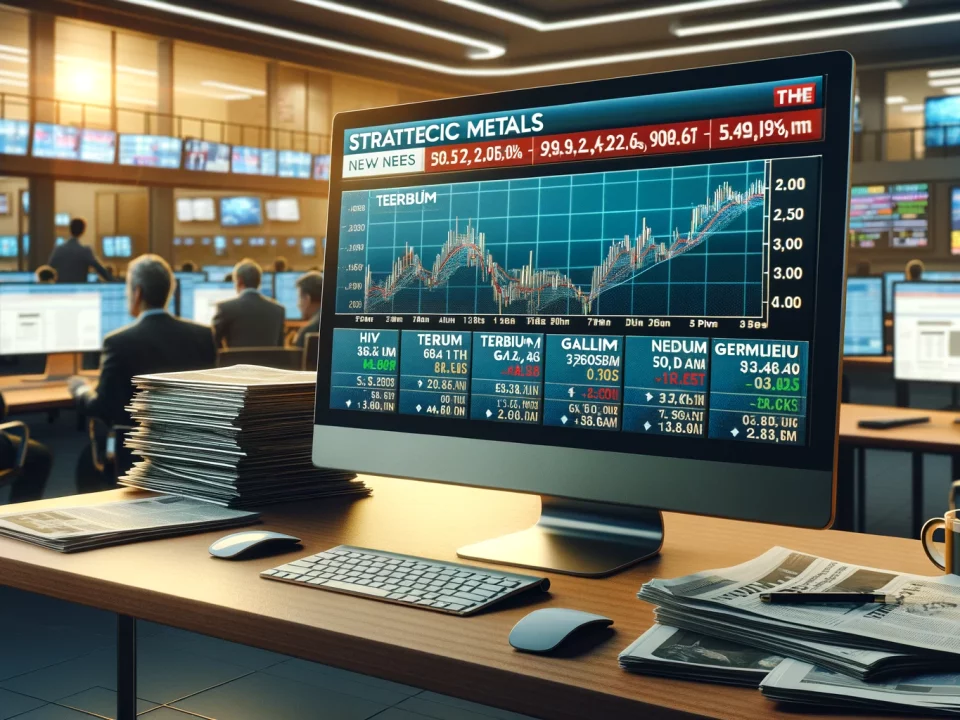
Weekly News Review February 10 – 16 2025
February 16, 2025
Weekly News Review February 17 – February 23 2025
February 23, 2025Not only will we likely experience supply bottlenecks over the next 5 to 10 years, but it is increasingly likely that there will be periods when strategic metals are not available at all due to the inflexibility of production.
Our industry partner (Tradium GmbH) has stated that insecurity will define the supply chain this year. Nation-states and global conglomerates are acting now to safeguard their production capabilities by strategically stockpiling critical raw materials.
Europe’s demand for strategic metals heavily relies on a few countries, notably China. Recent geopolitical tensions have heightened awareness of the risks posed by this one-sided supply chain.
“These dependencies and risks are only set to increase,” warns Matthias Rüth, Managing Director of TRADIUM GmbH. A strategic stockpiling approach for key resources such as rare earths, gallium, and germanium could prove invaluable 2025, helping businesses mitigate supply risks and avoid production halts.
Global Role Models: South Korea, Japan, and the USA:
A look beyond Europe’s borders reveals effective strategies already implemented by other nations to address this challenge. These countries use targeted stockpiling initiatives to minimize economic and geopolitical risks while bolstering industrial independence. Their approaches offer practical models for the future:
South Korea: Through its “Industrial Supply Chain 3050 Strategy“, the country is expanding public reserves and supporting private-sector stockpiles.
Japan: Since the 1980s, the Japan Oil, Gas and Metals National Corporation (JOGMEC) has coordinated strategic raw material stockpiling, including rare earths.
USA: The National Defense Stockpile maintains metal reserves critical to national defense and civilian needs.
China: The National Food and Strategic Reserves Administration is believed to oversee extensive reserves of critical resources, ranging from agricultural goods to technology metals like germanium.
European Union: The Critical Raw Materials Act aims to improve the documentation of critical raw material reserves across the EU. Foundational measures are expected within 24 months, but key implementation details remain unresolved.
Businesses: Act Now Rather Than Wait:
Until the EU-wide program takes effect, industries must prepare independently. In Germany, the government emphasizes that securing raw material supplies is primarily the responsibility of businesses, as stated in its latest Raw Materials Strategy.
However, too few companies are responding. In the summer of 2023, China’s export restrictions on gallium and germanium, combined with lengthy export license approval times, resulted in a near-total halt of metal exports from the country for over two months.
“Despite this unmistakable wake-up call, only a handful of raw material-processing companies in Europe have increased their stockpiles,” observes Matthias Rüth.
Financially driven companies often maintain minimal strategic reserves, which is understandable but carries significant risks. As they apply in Germany, tax disadvantages and the substantial capital required for stockpiling make it challenging to build safety reserves. The costs strain liquidity, leaving many businesses with limited room for such investments. Still, companies should weigh their options carefully.
UNITED STATES WITHDRAWS FROM THE PARIS CLIMATE AGREEMENT: A SETBACK FOR STRATEGIC METAL DEMAND?
For the second time since 2020, the U.S. is abandoning the Paris Climate Agreement. What could this decision mean for climate protection and the expansion of renewable energy? What impact can we expect on the demand for strategic raw materials? Our market commentary explores the potential consequences.
Just hours after taking office, U.S. President Donald Trump issued a decree initiating the country’s withdrawal from the Paris Climate Agreement. This marks the second time this has occurred: in 2020, under the same president, the U.S. also pulled out of the 2015 accord to combat climate change. The move was justified both then and now by claims of unfair burdens and potential harm to the domestic economy.
Only a Few Countries Remain Outside the Climate Agreement.
The Paris Climate Agreement is considered a milestone in the fight against global warming. 195 countries have committed to limiting the rise in global temperature and reducing emissions. The agreement also aims to achieve greenhouse gas neutrality in the second half of the 21st century.
Additionally, a climate fund has been established, into which industrialized nations contribute to assist poorer countries in coping with and combating global warming. If the U.S. were to withdraw again, it would join Iran, Yemen, and Libya as the fourth country not participating in the agreement.
Symbolic or Practical: What are the Possible Consequences of Withdrawal?
The withdrawal, which, according to the agreement, will only take effect next year, raises the question of whether previous climate protection efforts may have been, at least in part, in vain. On one hand, the U.S. withdrawal removes crucial financial support for the climate fund, as the U.S. is a significant contributor.
However, the symbolic impact may be even more critical if the world’s largest Western economy shifts its focus back to fossil fuels. “Drill Baby Drill!” – the slogan promoting expanded oil production – was a key part of Trump’s campaign.
Additionally, he has targeted subsidies for electric mobility and the expansion of wind energy, both cornerstones in the fight against climate change. There are currently no government plans to hinder or accelerate photovoltaics progress in the U.S.
Wind Energy Under Fire, but Resistance Is Emerging:
Also, an executive order halted in January the granting of licenses for constructing wind turbines on federal land, including coastal regions. However, a complete stop to wind energy expansion seems unlikely. Even after the U.S. first withdrew from the climate agreement five years ago, 24 of the 50 U.S. states committed to continuing the Paris Agreement and expanding renewable energy within their borders. This promise was renewed on the day of the most recent decree.
Notably, Republican states—Trump’s voter base—have seen the most significant increase in wind energy in recent years. This form of renewable energy has become a considerable job engine. In Texas, the leading location for wind energy, over 27,000 people are employed in the sector. More than 300,000 jobs across the U.S. depend on wind energy, with additional tax revenues from wind farms benefiting local communities.
Should the Trump administration successfully halt the expansion of wind power, despite expected resistance, it will impact the demand for raw materials. This is especially true for rare earth elements such as neodymium, praseodymium, and terbium, which are involved in converting the rotational energy of turbine blades into electricity via permanent magnets.
These materials are of central importance. Offshore and onshore wind farms, particularly those using neodymium-iron-boron (NdFeB) magnets, are preferred in coastal areas due to their reduced wear and lower maintenance needs than other turbine types.
According to analysts, wind energy generation in the U.S. remains in its infancy, and the potential may remain untapped under the current administration. As a result, the demand for NdFeB magnets would likely decrease. However, the duration of this is uncertain, as executive orders remain in effect only until they are rescinded or declared invalid by a successor or the courts.
What Does the U.S. Withdrawal Mean for Electric Mobility?
Alongside wind power, Trump’s presidency is also expected to affect electric mobility. Upon taking office, he reversed several measures from the previous administration aimed at promoting emissions-free vehicles, including the target of a 50% market share by 2030 and the expansion of charging infrastructure.
A review and possible removal of the tax incentives for electric vehicles, as outlined in the Inflation Reduction Act (IRA), has also been announced. Should the president succeed in this—despite legal hurdles and likely protests against dismantling IRA’s investment and job-driving provisions—it would have consequences for raw material demand. According to analysts, the U.S. demand for electric vehicles could slow, reducing the demand for rare earth elements. This is because, alongside wind turbines, electric motors are a key application for rare earth magnets.
Raw Material Demand Will Grow but in a More Diverse Way:
The anticipated energy and mobility policy realignment could affect the demand for certain raw materials. However, the extent of the decline will depend on whether other areas compensate for this shift.
There are growing opportunities in industrial robots and the defense sector regarding rare earths, as electric motors, pumps, and other key components often contain permanent magnets, particularly when space is limited and high performance is required. Meanwhile, the expansion of oil production would benefit rare earths like cerium and lanthanum, which are used as catalysts in petrochemical processes.
These two elements account for nearly three-quarters of the current demand for rare earth elements in the U.S.
Should nuclear energy gain ground at the expense of wind power, more dysprosium, erbium, gadolinium, holmium, and samarium would be needed. These rare earth elements are used in control rods or reactor linings.
Even if the trend shifts back toward combustion vehicles over electric ones, this group of elements will not disappear from the radar, as they are relevant for electronics and specific processes in conventional vehicle production.
Plug-in hybrids, which many U.S. consumers view as a transitional technology and currently prefer over battery-electric vehicles, also contain electric motors with rare earth magnets.
Matthias Rüth, Managing Director of TRADIUM, is confident that the demand for raw materials will persist and continue to grow.
“One thing is clear: strategic raw materials, such as rare earth and technology metals, will remain essential. However, shifts in demand are possible. While specific application areas may see a decline, this will be offset—or even surpassed—by growth in others. “
Rare Earth Elements Remain in Demand:
The significance of rare earths and other critical raw materials to the Trump administration is underscored not only by its expressed interest in Greenland’s mineral resources and Ukraine’s rare earth deposits but also by plans to increase domestic extraction.
Globally, the expansion of renewable energy is unlikely to be halted even after the U.S. withdrawal from the Paris Climate Agreement. In China, for example, there are plans for massive growth in wind energy. The country sets new records each year, driving the demand for vast quantities of critical raw materials. The same applies to electric mobility in the People’s Republic.
What This Means for Private Investors
While governments and corporations are moving to secure their supply of strategic metals, private investors have a unique opportunity to benefit from this unfolding scenario. The same supply constraints and geopolitical shifts that pose risks to industries also create the potential for significant value appreciation in critical raw materials. Metals like gallium, germanium, and rare earths are not just essential for the future of technology—they are also tangible assets that offer a hedge against inflation, supply chain volatility, and geopolitical uncertainty. By owning these metals directly, investors can position themselves ahead of growing demand and tightening supply.
Want to learn more about how to invest in strategic metals? Let’s discuss your options. Schedule a call with us today to explore how you can add these high-demand resources to your portfolio before shortages drive prices even higher.






